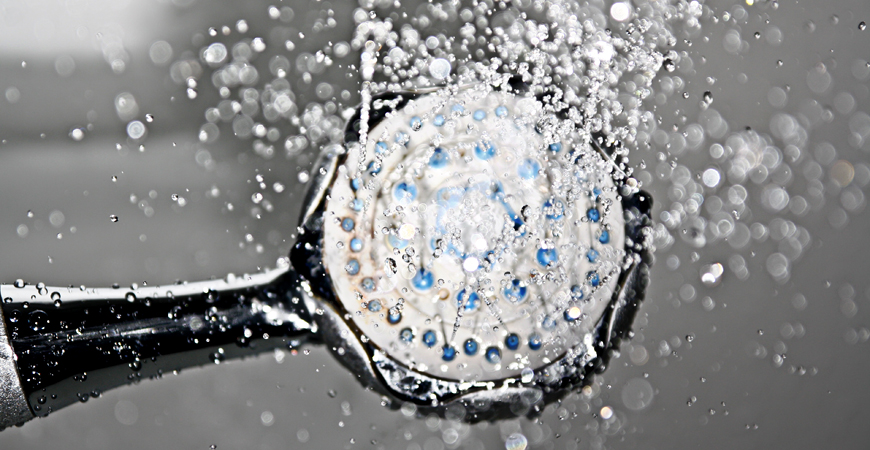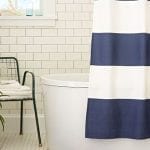
Is Your Showerhead Water Pressure Too Low? Here’s How to Fix It
Has the once-strong flow of water from your showerhead slowed to a dribble? A steady flow of H2O is essential to getting the maximum clean and enjoyment from your shower.
Capture that squeaky clean feeling again by fixing your showerhead’s low water pressure problem with these simple DIY hacks.
How to Clean a Clogged Showerhead
Over time, showerheads can gradually build a layer of soap, grime, and hard water deposits. These nasties will eventually clog the showerhead, which results in low water pressure.
Here are a few simple ways to clean your showerhead:
Clean With Vinegar-
Grab a plastic storage bag and wrap it loosely around the head. Pour in a cup of white distilled vinegar. The vinegar acts as a mild acid to remove mineral deposits.
Hold the bag tight and use a twist tie to attach the bag to the showerhead, ensuring the head is submerged in the vinegar. Let the head soak for a minimum of 24 hours.
Remove the bag and use a toothpick to remove any remaining mineral particles stuck to the shower nozzle. Check the flow of water in the shower.
It may be necessary to repeat the vinegar clean more than once, but it will save you the cost of replacing the entire head with a new one.
Vinegar Cleaning Method 2
Unscrew the head and soak it in a tub of white distilled vinegar overnight. Use a toothpick to remove any remaining loose mineral particles from the shower nozzle.
Use a Toothbrush-
Another excellent cleaning option to improve your showerhead’s low water pressure is just by using a toothbrush. Dip an old toothbrush in soapy water and “brush” the showerhead to eliminate clogs.
Turn on the water to recheck the pressure. Do not use abrasive cleaners on your showerhead as they may scratch the metal or plastic surfaces.
Extra Tip: If you still see mineral deposits on your shower head, remove your showerhead and run it through the dishwasher. Add a detergent booster for hard water to your original detergent to help remove calcium build-up on your showerhead.
Remove the Aerator
Aerated showerheads include a small component that pulls air into the pressurized water. The tiny air ducts can easily clog with mineral deposits, creating low water flow.
Refer to your showerhead owner’s manual to learn how to remove the aerator and then recheck the water pressure. If there is no improvement, reinsert the aerator.
For more information on how an aerator can affect water pressure, click here.
Remove the Flow Regulator
Flow regulators restrict water flow but don’t necessarily create a high-pressure shower experience. The Clean Water Act of 1992 (U.S.) imposed low-flow showerheads at a 2.5 gallons-per-minute maximum flow and 1.6 gallons-per-minute flush toilets.
Most showerheads sold today do not provide the desired flow and pressure. You can boost your shower head’s water pressure by removing the added plastic flow regulator.
The flow regulator is easy to spot. It’s a color plastic disc that covers the showerhead inlet, plus it’s simple to remove. Use a paper clip to pry up and pull out the regulator.
When you remove the flow regulator, you should see a big difference in the shower water pressure.
Water Leaks
A water leak will divert flow away from the showerhead, resulting in low water pressure. Turn on the shower and check if the water leaks from any surrounding connections.
The Teflon tape in the threaded end of the shower arm may be damaged or wrapped improperly. If the Teflon tape is worn, remove it and wrap the new tape around the threaded end of the shower arm.
Use a wrench to re-attach the showerhead connector to the shower arm. If you suspect a leak behind the shower wall, it’s best to contact a plumbing professional.
Click here for more information on repairing simple shower water leaks.
Main Shut-off Valve Adjustment
A quick fix to improve water pressure is to ensure the central shut-off valve is fully open. Poor showerhead pressure can occur from a partial shutoff valve.
Water Volume at the Curbside Main
If your home is newly constructed or construction has occurred nearby, the curbside main could be to blame. The main valve may have been turned down during activity and left on a low setting.
The valve should be turned completely on (completely counter clock-wise). Call your local water municipality and request a professional to help check the curbside main.
Buy a New Showerhead
As a last resort, buy a new showerhead to deliver high pressure. A higher pressure shower provides an enjoyable, cleaner wash.
The increased water pressure is provided by either adjustable spray settings or a pressure chamber design. The adjustable spray setting condenses the spray for a narrower but more powerful shower. A pressure chamber adds air to the water.
The addition of air will force water out at a higher speed rate, providing you with a more enjoyable shower. Most high-pressure showerheads have easy installation – several designs screw into place.
Other Answers-
Insufficient Indoor Plumbing
Some older homes may lack adequate plumbing, or the pipes may be clogged. If your water pressure is low in every room, not just the shower, this may be the cause.
Consult with a local plumbing professional to help remedy the problem.
Call the City
Call your water municipality if you’ve still got a showerhead water pressure problem after trying all the above remedies.
There may be an issue with the water coming from the street to your home. Contact your local water department to check your pressure reading if you use city water. A 45-55 psi reading is ideal.
Consider installing a water pressure booster if your water department cannot provide adequate pressure. Use a booster if you have a 3/4-inch or larger water main coming to your house.
A water pressure booster includes an electric pump, a pressure tank, and an adjustable dial to set the pressure between 45 to 55 psi. Water pressure boosters are available at Lowe’s or home improvement centers.
Adequate water pressure can mean the difference between a so-so shower and an enjoyable cleaning shower experience. Fix that annoying showerhead water pressure problem, and you’ll be rewarded with relaxing, pleasant showers for years to come.















Hls
TheThe past three showers I noticed low water pressure. The dial on the showerhead would not budge, so I figured it was mineral deposits holding it like cement so I sprayed it with lime away and let it sit 5 minutes Then I wrapped a bag around the showerhead with vinegar for about four hours. I say the water pressure improved by 90%. I guI guess it was good enough to take a shower.